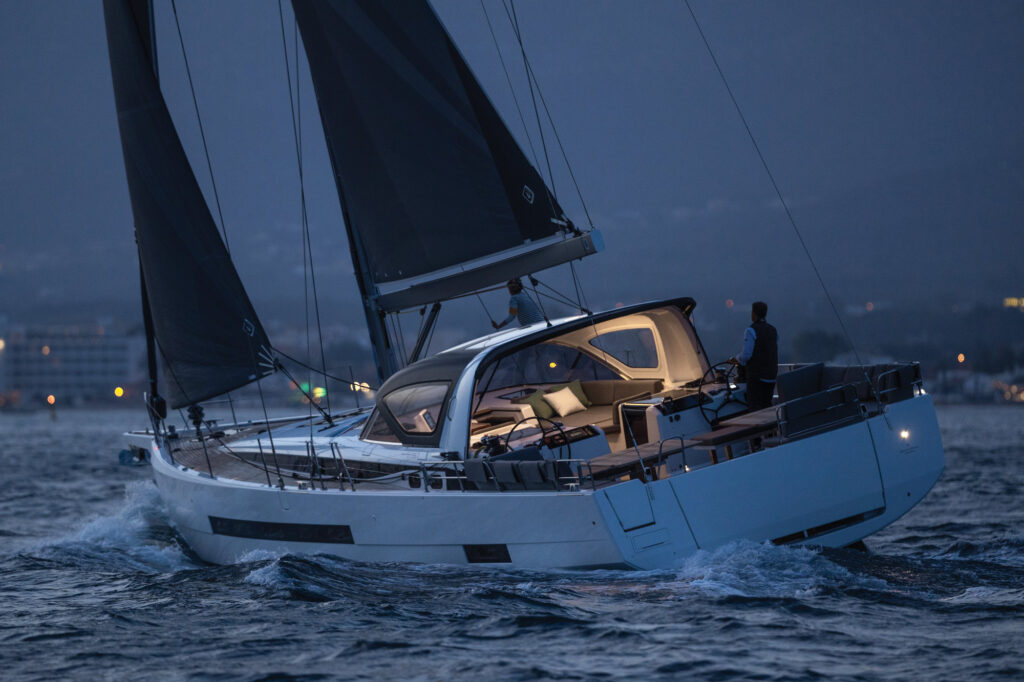
One way to gauge the relative success of a production sailboat is to look at the size of the model’s run: the quantity of hulls sold or the number of years it was offered. After investing in research and development, not to mention tooling and marketing, a company needs to spread those costs over as many boats as possible. To be a winner, a new model should be versatile and appeal to as many buyers as possible. Often, this means multiple layouts and options to meet the needs (and budgets) of private owners and charter companies.
But for the latest sailboat in the Jeanneau Yachts range, the French builder decided to focus primarily on owners. This 55-footer has a layout that borrows concepts more often found on midsize multihulls. There are spacious accommodations for the owner, separate staterooms where guests can come and go without disturbing one another, multiple places to gather or find privacy, and protected spots to navigate and spend time off watch—without having to be down below.
The result is a very different sort of sailboat. In fact, it would be safe to say that Cruising World’s Boat of the Year judging team had never seen anything quite like it when we arrived for a dockside inspection during the Annapolis Boat Show this past October in Maryland. In the end, we obviously approved of the concept. The Jeanneau Yachts 55 not only earned the title of Best Full-Size Cruiser, but it also it went on to take top honors as the 2024 Boat of the Year.
With so much that’s new and different about the 55, let’s start with what you discover the moment you board using the fold-down swim platform. You then step up to encounter a living/lounging/working area that starts at the transom and stretches forward to take up nearly half the boat’s topsides. The builder calls it a dual-cockpit layout, but that barely begins to describe all that’s going on there.
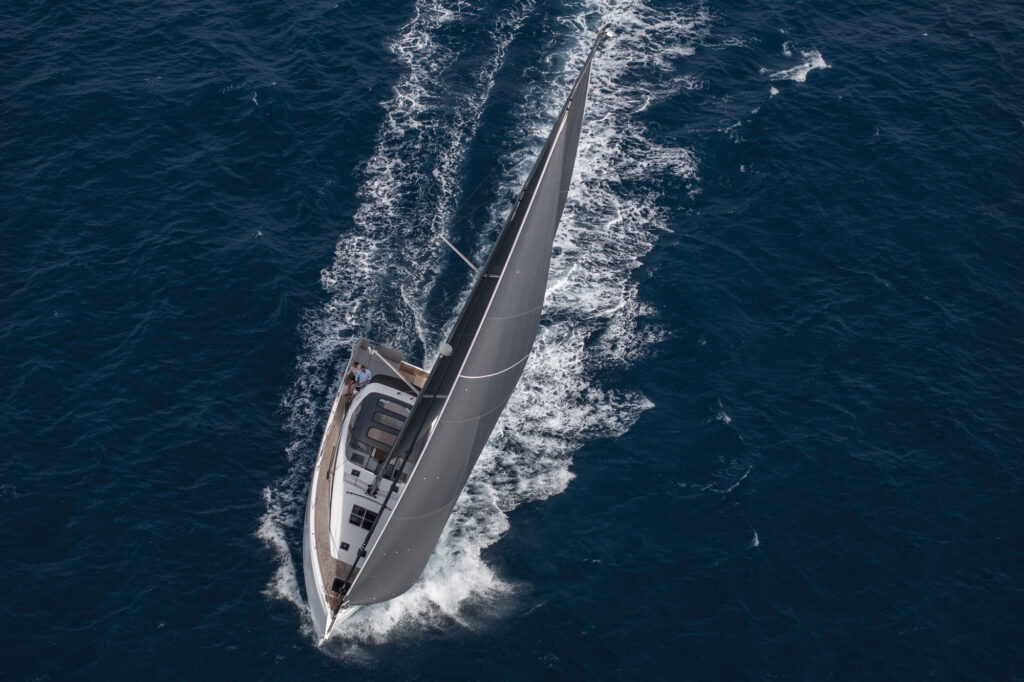
Two cushioned seating areas—one is U-shaped to starboard, and the other is an upside-down L-shape to port that opens up a walk-through path for boarding—are located across the transom. Each one surrounds a table that can be lowered to create party-size sun lounges. With the boat’s beam of 16 feet, 4 inches, that’s a lot of room to kick back and relax.
Under the port seats, there’s life-raft storage, and between the tables, there’s access to a garage below the deck. It could handle toys, an inflatable or even a Tiwal sailing tender.
Between the lounges and the pair of helm stations located just forward of them, there’s access on either side of the boat to the walk-around side decks that have become a Jeanneau trademark.
A fiberglass cockpit arch rises up just forward of the steering wheels. On the boat we visited in Annapolis, it connected an optional hard spray hood that covered the forward portion of the cockpit and main companionway, and a hard Bimini top (also an option) that protected the aft area. The Bimini had a nifty sliding fabric panel in the middle that could be opened for sun and stars, or shut for shade and rain.
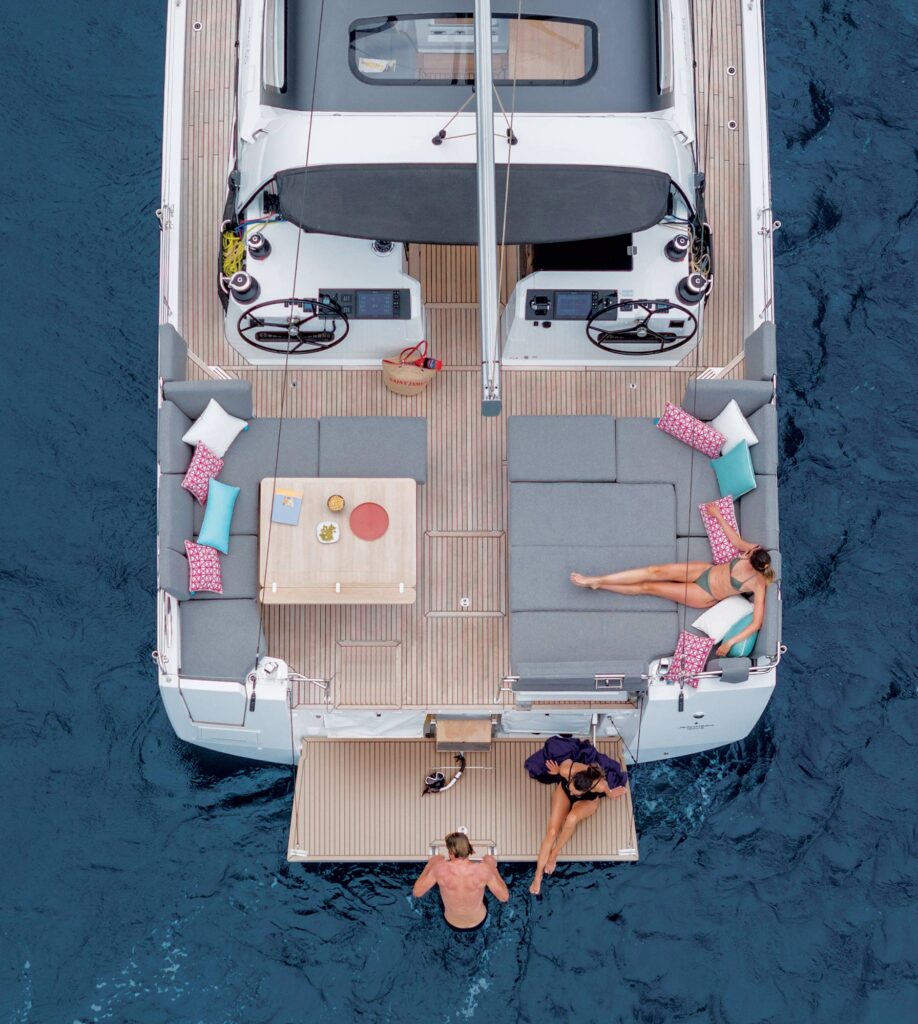
Two more companionways are just under the arch, providing access to two private port and starboard guest staterooms. We’ll get to them in a minute. But first, let’s complete the tour of the topsides.
Tucked up forward, under the rigid spray hood, there is another smaller table to starboard with U-shaped seating around it. Call it a breakfast nook or a fine spot to sit and enjoy a book, no matter the weather outside. It’s opposite a forward-facing navigation desk with a chart plotter. Here, a watchkeeper is protected from the elements but still has a clear view all around.
Much like on a catamaran, there’s a provision for another cushioned lounge area on the broad foredeck, giving guests another place to enjoy the great outdoors.
The 55’s interior accommodations, designed by Andrew Winch, are just as unique as those found topsides. The builder describes the layout as being “owners first.”
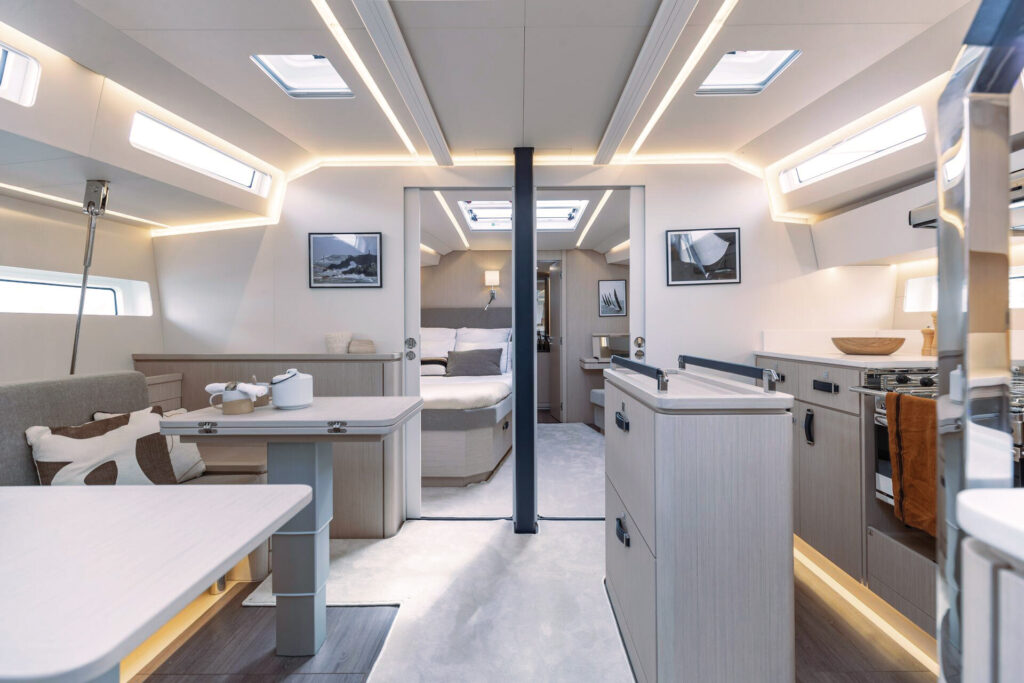
I mentioned that two guest staterooms are accessible only from the cockpit. These give the crew (and owners) privacy that’s not possible on a conventional monohull, where all of the staterooms open into the salon.
To port is a VIP stateroom with en suite head and shower, and enough additional space to allow for a small sitting area with a desk or vanity. The starboard guest stateroom, also with en suite head and shower, is a bit smaller because of the location of the galley in the salon, but it still has a double berth. Both staterooms have 6-foot-5-inch headroom.
Stepping down the main companionway and into the salon and master stateroom, the first thought that comes to mind is that it resembles an efficiency or one-bedroom condo in some urban center. In fact, two-thirds of the interior space is intended for those paying the bills. A dining area with L-shaped seating takes up the port side of the salon, with a large-screen television mounted on the forward bulkhead for movie nights.
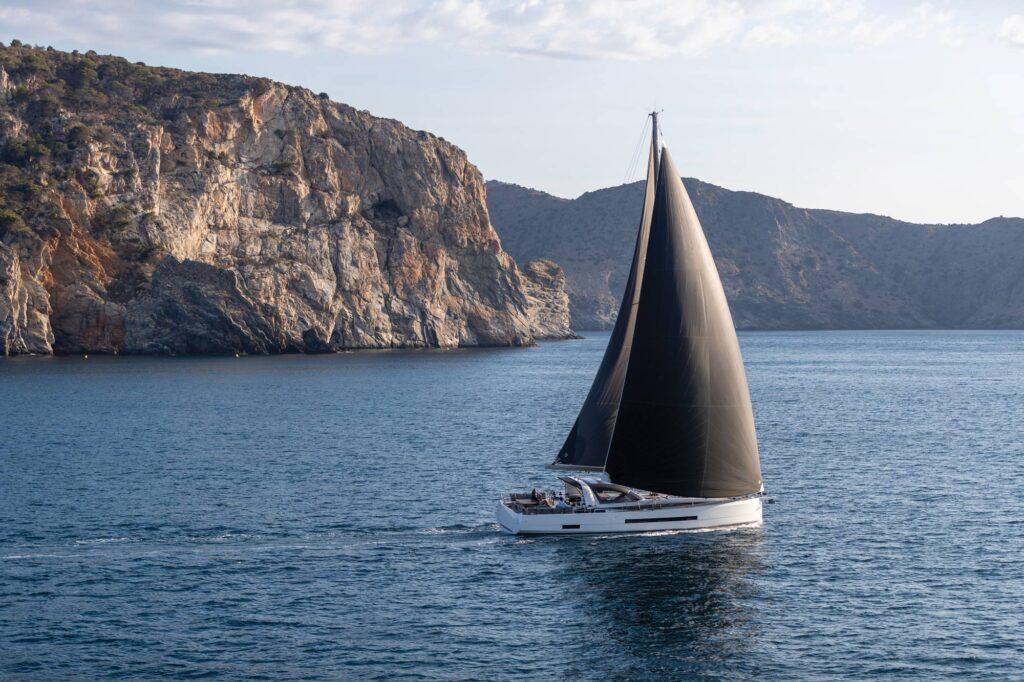
A galley is opposite, with an island counter amidships, giving the cook a solid place to brace while preparing meals underway.
Ports in the cabin top and hull let in loads of light, and white walls and overhead panels help keep things bright. The boat we sailed had teak-colored Alpi bulkheads and furniture; white oak is another option.
The owner’s stateroom is forward, through double doors. A double berth is offset to port, with lockers and a sitting area to starboard. A spacious head and shower compartment is farther forward.
Depending on how an owner plans to use the boat, the forepeak can be either a sail locker or a crew cabin.
Buyers also have options when it comes to a standard keel (8-foot) or shoal draft foil (6-foot-2-inch), and either a standard in-mast furling rig or a performance spar with full-batten main. The boat we sailed had the former, coupled with a versatile three-headsail sail plan that included a self-tending jib to simplify tacking upwind, an overlapping genoa for light-air days (both with electric furlers), and a downwind sail that’s flown from a continuous-line furler.
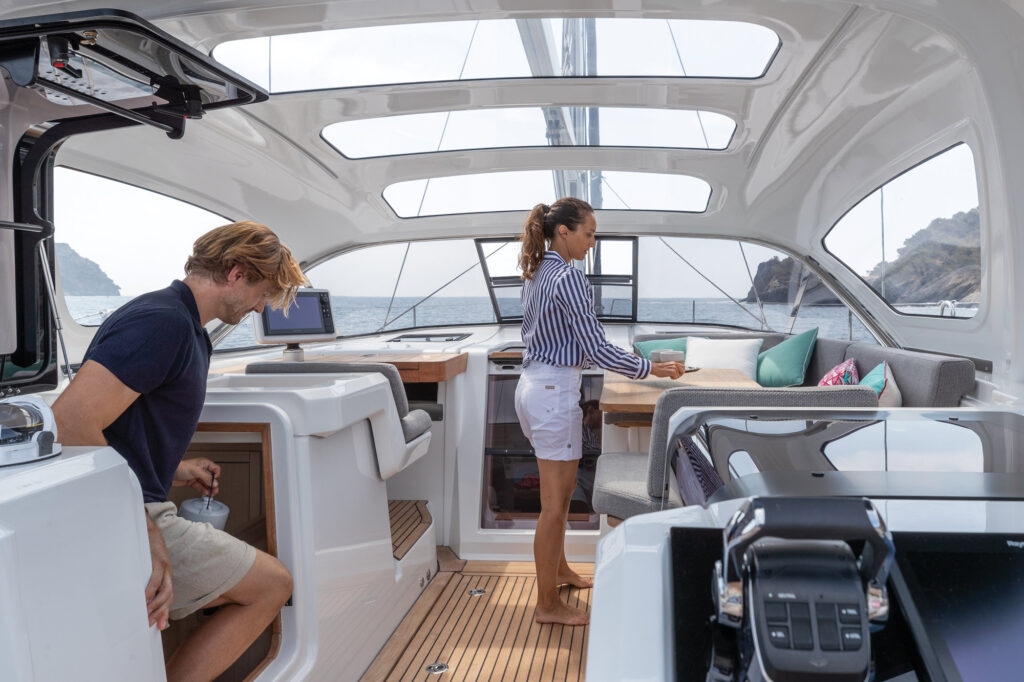
For motoring, the 55 is equipped with a 110 hp Yanmar diesel with a shaft drive and a three-blade Flexofold prop—and a bow thruster for close-quarters maneuvering. If I had to pick a nit, it would be engine access, which was through a hatch in the cockpit sole. It seemed adequate enough, though not necessarily convenient.
Loaded up with electronics and options, the price tag on the 55 in Annapolis was right around $1.4 million. That included Jeanneau’s Seanapps system, which provides remote boat monitoring, alerts and maintenance recommendations.
Underway, I found the 55 comfortable. The walk-around decks made it easy and safe to move about, and when I wasn’t doing the sailing, there were numerous places to relax and take in the sights.
When my turn came at the wheel, visibility all around was excellent, and electric winches made trimming sails effortless during singlehanded maneuvers. Steering by hand, you can stand inboard, out of the elements, or step out onto the side deck to feel the breeze in your face as you lean an arm over the stainless-steel life rail that encircles the cockpit.
Our test sail took place on Chesapeake Bay in variable conditions that ranged from nearly no breeze to gusts well into the high teens. Tacking in light air—about 5 knots or less—boatspeed was 3 to 4 knots. Later, reaching in 17- to 20-knot puffs, we trucked along effortlessly at 7-plus knots. Some boats do well in light air; some like big wind. The 55 lit right up in both. No wonder it’s a winner.
Designing Outside the Box
A casual sailor walking the docks at a boat show could be excused for thinking that these days, new boats all look pretty much alike. Sure, “innovations” are introduced annually, but a barbecue grill built into the transom or two cockpit tables instead of one are hardly radical innovations. And chines in the hull? Yup, pretty much everybody’s got ’em too now.
But in fall 2023, there wasn’t any other new sailboat introduced to North America that looked anything like the Jeanneau Yachts 55.
When the concept for the boat began to take shape under the shadow of the pandemic, Erik Stromberg, currently the vice president of power and motor yacht development at Jeanneau, was still a sailboat guy and leader of the design team. Tasked with coming up with a sistership for the Jeanneau Yachts 60 and 65, his logical step might have been to simply scale things down. And in fact, designer Philippe Briand did just that.
But the design team also asked, “What happens if you take a 55-foot boat and design it the way people actually use and live on the boat?” Stromberg says. Answering that question led them down a concurrent conceptual path—still toward a big, elegant cruising yacht, but one with more protection and bigger spaces to live in on deck, not to mention a different approach to staterooms that might not be used all the time.
Briand and interior designer Andrew Winch listened to the ideas and went to work.
Ironically, this owner-focused boat drew inspiration from an earlier Jeanneau model called the Sun Loft 47, a six-stateroom vessel designed strictly for Yacht Week events in Europe, where charterers pack the boat with as many people as possible. To make room for six staterooms belowdecks, the galley and entertaining area on the Sun Loft were moved topsides. With the onset of COVID-19, though, chartering shut down, and demand for the Sun Loft waned.
Stromberg says that so far, Jeanneau has orders for more than 30 of the 55s, and the boat is showing broad appeal in Europe and Asia. Here in the States, two were sold during the show in Annapolis—one to a couple who plans to go cruising with their 10-year-old daughter, and another to a couple on the Great Lakes who want a boat to sail and entertain friends. A third is under consideration by a couple of engineers who want to have their offices on board.
Stromberg says that the yard can build 17 or 18 boats a year, and the production run should fall somewhere in the 60- to 70-boat range. He calls the Yachts 55 an interesting project, the challenge being to stay within the limits of what has to work on a sailboat while still being creative.
“We need to keep innovating,” Stromberg says.








